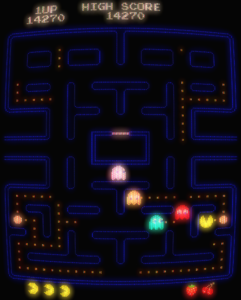 The Game: As a round yellow creature consisting of a mouth and nothing else, you maneuver around a relatively simple maze, gobbling small dots (10 points) and evading four colorful monsters who can eat you on contact. In four corners of the screen, large flashing dots (50 points) enable you to turn the tables and eat the monsters
The Game: As a round yellow creature consisting of a mouth and nothing else, you maneuver around a relatively simple maze, gobbling small dots (10 points) and evading four colorful monsters who can eat you on contact. In four corners of the screen, large flashing dots (50 points) enable you to turn the tables and eat the monsters  for a brief period for an escalating score (200, 400, 800 and 1600 points). Periodically, assorted items appear near the center of the maze, and you can consume these for additional points as well. The monsters, once eaten, return to their home base in ghost form and return to chase you anew. If cleared of dots, the maze refills and the game starts again, but just a little bit faster… (Tengen, 1985)
for a brief period for an escalating score (200, 400, 800 and 1600 points). Periodically, assorted items appear near the center of the maze, and you can consume these for additional points as well. The monsters, once eaten, return to their home base in ghost form and return to chase you anew. If cleared of dots, the maze refills and the game starts again, but just a little bit faster… (Tengen, 1985)
Memories: You’ve gotta hand it to Atari – back in the day, they were the experts at exploiting a license until just about every possible option was exhausted. They were also quite adept at staying on the map – up to a point. Where this title might have been released by Atarisoft only a year or two earlier, Atari set up a new imprint – Tengen – to create and market games for the NES. By virtue of Atari’s existing license with Namco, Tengen threrefore produced the first NES port of Pac-Man, and Namco later released its own. (It’s worth noting that the Namco-Atari connection – forged in the late 70s when Namco distributed Atari arcade games in Japan – wasn’t history just yet; Atari later handled the American release of Namco’s Pac-Mania coin-op.)
 Tengen’s Pac-Man has some visual quirks – the proportion of Pac himself to the ghosts is a little off, and the maze seems to be off thanks to a series of black horizontal lines – and it doesn’t quite get the sound right, but those minor details aside, it’s hard to believe that this version of Pac-Man came out of the same company that had, only half a decade before, given the world the most miserable Pac-Man experience imaginable on one of its own consoles.
Tengen’s Pac-Man has some visual quirks – the proportion of Pac himself to the ghosts is a little off, and the maze seems to be off thanks to a series of black horizontal lines – and it doesn’t quite get the sound right, but those minor details aside, it’s hard to believe that this version of Pac-Man came out of the same company that had, only half a decade before, given the world the most miserable Pac-Man experience imaginable on one of its own consoles.
Tengen didn’t get to celebrate for long, however. Part of the problem that caused the 1983/84 video game industry crash in the first place was the glut of third-party cartridges for the pre-NES consoles, especially the Atari VCS. Nintendo intended to rectify this problem by forcing anyone who wanted to manufacture NES cartridges pay for a license to do so – and without the license, Nintendo wouldn’t hand over the security code required by any cartridge to get the machine to boot up. A few gutsy distributors like Tengen/Atari set about reverse-engineering that security code to circumvent the pricey licensing, but in subsequent court cases, it was discovered that Atari lawyers had obtained the schematics of that security system by fraudulent means (and programmers and engineers such as Ed Logg still maintain that they knew nothing of the attorneys’ end-run around Nintendo). Already locked in an  expensive court battle with Nintendo over what Atari claimed were unfair business practices (though Atari couldn’t find a judge who agreed), and still smarting from a battle over the home cartridge rights to Tetris, Atari eventually gave in and paid up to make its Tengen division an official Nintendo licensee, but even then, many of Atari’s own in-house properties went unexploited on the NES.
expensive court battle with Nintendo over what Atari claimed were unfair business practices (though Atari couldn’t find a judge who agreed), and still smarting from a battle over the home cartridge rights to Tetris, Atari eventually gave in and paid up to make its Tengen division an official Nintendo licensee, but even then, many of Atari’s own in-house properties went unexploited on the NES.

